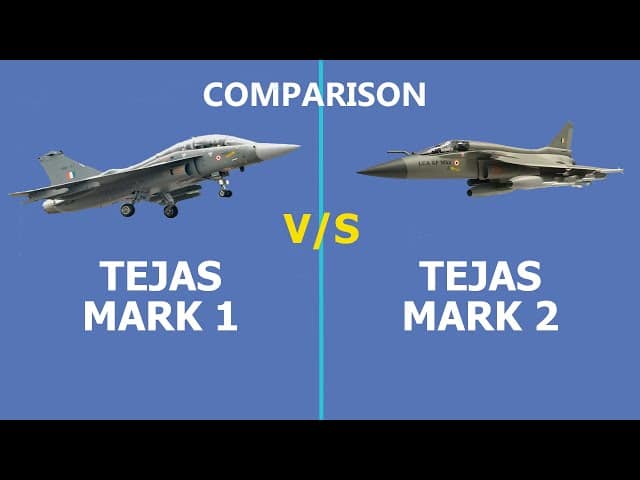Aircraft comparison
Comparison between Tejas mk 1 and Tejas mk 2

Tejas Mk and Tejas Mk 2 are two models of India’s Tejas Light Combat Aircraft (LCA), an indigenously produced fighter aircraft.
In this video, we’ll have a look at the two Tejas fighter jet types, one of which India is now employing and the other of which is scheduled to launch next year while engines are still being developed. Let’s learn more about this fighter jet and what makes these two planes remarkable and one of a kind.
The Tejas Mk1, usually referred to as the HAL Tejas, is a light combat aircraft created for the Indian Air Force (IAF). It is a single-seat, single-engine, multi-role fighter aircraft made to suit the requirements of the Indian armed forces.
while Tejas Mk2, also referred as the Tejas Mark 2, is an upgraded variant of the Tejas, a light combat aircraft (LCA) created by the Indian companies HAL and Aeronautical Development Agency.
The Tejas Mk2 is intended to be a multi-role fighter aircraft with the ability to carry out a variety of tasks, including as air superiority, ground attack, reconnaissance, and electronic warfare.
The Tejas Mk1 has great maneuverability and agility in combat with its delta wing design and tail-less compound delta platform. It has cutting-edge avionics and equipment, including fly-by-wire flying controls, cutting-edge radar, and capability for electronic warfare. The aircraft’s combat radius is about 300 kilometers, and its top speed is Mach 1.8.
The Tejas Mk2 features a combination of cutting-edge composite materials, such as carbon fibre composites, which help to reduce weight and increase structural strength. The aircraft has a quadruplex digital fly-by-wire flight control system, which offers superior handling characteristics and increased maneuverability.
The Tejas Mk1 is equipped with a variety of air-to-air and air-to-surface weapons. It is powered by a single General Electric F404-GE-IN20 engine, which provides a thrust of around 53 kN. Whereas Tejas Mk2 will be propelled by two General Electric F414-GE-INS6 engines, which will deliver more thrust and better performance than the Tejas Mk1’s single engine.
While both variants are members of the same family, there are several notable differences between them.
Here’s a comparison between Tejas Mk and Tejas Mk 2:
- Size and Weight:
- Tejas MK1: The MK1 has a length of 13.2 meters (43.31 feet) and a wingspan of 8.20 meters (26.90 feet). It has a maximum takeoff weight of around 13,500 kg (29,760 lbs).
- Tejas MK2: The MK2 is slightly larger, with a length of 14.65 meters (48 feet) and a wingspan of 8.50 meters (27.56 feet). Its maximum takeoff weight is expected to be around 17,500 kg (38,580 lbs).
- Engine:
- Tejas MK1: The MK1 variant is powered by a single GE F404-GE-IN20 turbofan engine, which provides a maximum thrust of approximately 85 kN (19,000 lbf)
- Tejas MK2: The MK2 variant is expected to feature a more powerful engine, the General Electric F414-GE-INS6 turbofan engine, with a maximum thrust of around 98 kN (22,000 lbf).
- Avionics and Electronics:
- Tejas MK1: The MK1 variant is equipped with a range of avionics and electronics, including an advanced glass cockpit, Multi-Mode Radar (MMR), and advanced electronic warfare suite.
- Tejas MK2: The MK2 variant is planned to have upgraded avionics, including an Active Electronically Scanned Array (AESA) radar, advanced electronic warfare systems, and improved sensors.
- Payload and Armament:
- Tejas MK1: The MK1 variant has eight hardpoints for carrying various air-to-air and air-to-ground weapons, with a maximum payload capacity of around 5,300 kg (11,700 lb).
- Tejas MK2: The MK2 variant is expected to have an increased payload capacity, with the ability to carry a wider range of weapons, including air-to-air, air-to-ground, and anti-ship missiles.
- Performance:
- Tejas MK1: The MK1 variant has a maximum speed of Mach 1.6 (1,980 km/h or 1,230 mph) and a service ceiling of around 16,000 meters.
- Tejas MK2: The MK2 variant has a maximum speed of Mach 1.8 and a service ceiling of around 17,300 m (56,758 ft).
It’s important to remember that the Tejas Mk2 is still in the development stage, and as such, the above-mentioned parameters could change as the project moves forward.

